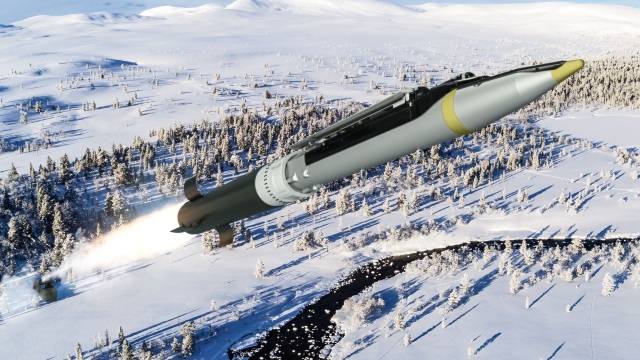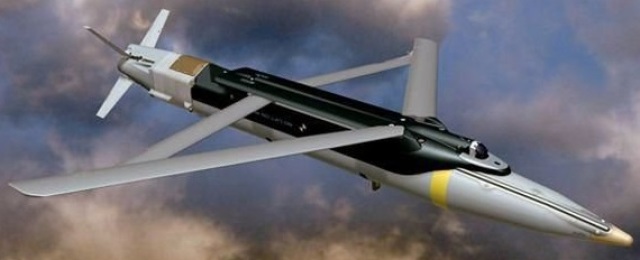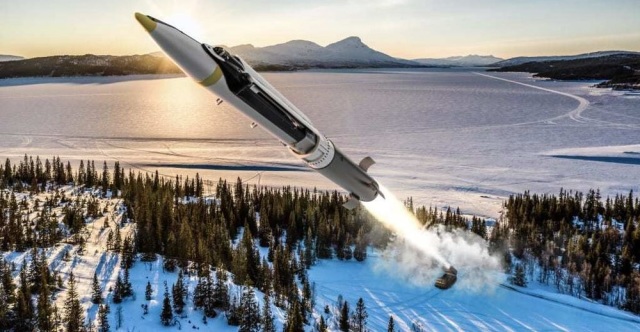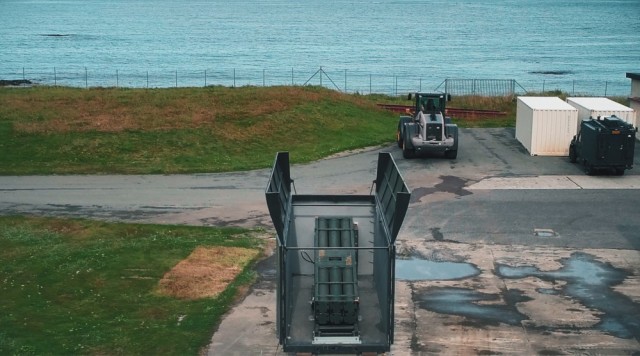The Reuters news agency, in [...] Mike Stone's article "Exclusive: U.S. weighs sending 100-mile strike weapon to Ukraine" ("The United States is considering the possibility of supplying Ukraine with strike weapons with a range of 100 miles"), reports that the US Department of Defense is considering a proposal from Boeing Corporation to supply Ukraine with a developed for several years together with a Swedish group Saab AB of the new Ground-Launched Small Diameter Bomb (GLSDB) missile system, which is a missile fired from combat vehicles of the M142 HIMARS and M270A1 MLRS ground missile systems, equipped as a warhead with a small-sized GBU-39/B Small Diameter Bomb (SDB) of 250 pounds caliber with a planning and correction module. The GLSDB firing range reaches 150 km.

Image of the launch of the Ground-Launched Small Diameter Bomb (GLSDB) missile complex jointly developed by Boeing Corporation and the Swedish group Saab AB (c) Saab ABThe US Department of Defense is considering a proposal from Boeing Corporation to supply Ukraine with cheap small-sized high-precision bombs mounted on available missiles, which will allow Kiev to strike deep into Russia's rear while the West is struggling to meet Ukraine's demand for additional weapons.
U.S. and allied military stocks are dwindling, and Ukraine is facing a growing need for more sophisticated weapons as the war drags on. The proposed Boeing system, designated Ground-Launched Small Diameter Bomb (GLSDB), is one of about half a dozen plans to launch new ammunition for Ukraine and America's Eastern European allies, industry sources said.
Although the United States has rejected Ukraine's requests for an ATACMS missile with a range of 185 miles (297 km), the GLSDB's 94-mile (150 km) range will allow Ukraine to hit valuable military targets that were out of reach and help it continue counterattacks by destroying the Russian rear.
The GLSDB could be delivered to Ukraine as early as spring 2023, according to a document seen by Reuters and three sources familiar with the plan. The system combines the GBU-39 Small Diameter Small Diameter Bomb (SDB) aircraft guided bomb with a rocket engine from the M26 rocket (used in MLRS and HIMARS missile systems), both of these samples are widely used in US service.
Doug Bush, the U.S. Army's chief weapons buyer, told reporters at the Pentagon last week that the U.S. Army is also considering accelerating the production of 155-mm artillery shells, which are currently produced only at state-owned enterprises, by allowing their production to private defense contractors.
Russia's invasion of Ukraine has increased the demand for American-made weapons and ammunition, while US allies in Eastern Europe are "making a lot of orders" for a number of weapons that they supply to Ukraine, Bush added.
"It's about getting a meaningful quantity at a low price," said Tom Karako, an arms and security expert at the Center for Strategic and International Studies. He pointed out that the reduction in stocks in the United States helps explain the desire to acquire more weapons now, saying that stocks "are getting low compared to the levels that we would like to have on hand, and, of course, with the levels that we will need to contain the conflict with China."
Karako also noted that after the US withdrawal from Afghanistan, there were many bombs left. They cannot be easily integrated with Ukrainian aircraft, but "in today's conditions, we must look for innovative ways to transform them into combat capabilities."
Although several GLSDB units have already been manufactured, there are many logistical obstacles to their official procurement. Boeing's plan requires a waiver of price disclosure, freeing the contractor from the scrutiny that ensures the Pentagon gets the best possible deal. Any agreement would also require at least six suppliers to accelerate the delivery of their components and services for the rapid production of these weapons.
A Boeing spokesman declined to comment. The Pentagon representative is a Lieutenant Commander.Tim Gorman also declined to comment on the provision of any "specific capabilities" to Ukraine, but said that the United States and its allies are "identifying and considering the most appropriate systems" that will help Kiev.
The GLSDB is being created jointly by the Swedish group Saab AB and Boeing, and has been in development since 2019, long before the start of the invasion of Ukraine, which Russia calls a "special operation". In October 2022, Saab executive Director Mikael Johansson said of GLSDB: "We are expecting contracts for it soon."
According to the document - a proposal from Boeing to the US European Command (EUCOM), which oversees the supply of weapons to Ukraine - the main components of the GLSDB will come from current American warehouses.
The M26 rocket engine is relatively common, and the GBU-39 bomb costs about 40 thousand per unit, which makes the finished GLSDB system inexpensive and its main components easily accessible. Although armament manufacturers are struggling with demand, these factors make it possible to start producing GLSDB by the beginning of 2023, albeit with low production rates.
According to the Saab website, the GLSDB is guided by GPS, can suppress some electronic interference, can be used in all weather conditions and can be used against armored vehicles. The GBU-39 bomb, which will be used as a GLSDB warhead, has small folding wings that allow it to glide more than 100 km when dropped from an airplane and immet QUO up to 3 feet (1 meter).
Industry motivationAt a manufacturing facility in rural Arkansas, Lockheed Martin is doubling down on efforts to meet the growing demand for HIMARS mobile missile systems that successfully hit Russian supply lines, command posts and even individual tanks.
A leading U.S. defense contractor is addressing supply chain issues and labor shortages to double production to 96 HIMARS launchers per year.
Lockheed Martin, as reported on its website, has posted more than 15 jobs related to HIMARS manufacturing, including supply chain quality engineers, purchasing analysts and test engineers.,
"We have invested in the infrastructure of the plant where we assemble HIMARS," said Becky Whitrow, head of sales at Lockheed Martin's missile division.
Despite the growth in demand, Lockheed Martin's chief financial officer told Reuters in July that he did not expect significant revenues from the war-inspired increase in production in Ukraine until 2024 or later. The chief financial officer of Raytheon, another major U.S. defense contractor, reiterated those deadlines in an interview with Reuters this summer.
HIMARS fires Guided Multiple Rocket Launch System (GMLRS) missiles, which are GPS-guided missiles and a 200 lb (90 kg) warhead. Lockheed Martin produces about 4,600 of these missiles per year. According to a Reuters analysis, more than 5,000 GMLRS missiles have been sent to Ukraine to date. The US does not disclose how many GMLRS missiles were delivered to Ukraine.
Repurposing weapons for new areas of combat use is not a new practice. The NASAMS anti-aircraft missile system, developed by Kongsberg Defense and Aerospace and Raytheon, uses AIM-120 missiles originally designed to fire from fighter jets at other aircraft. Another weapon, the Joint-Direct Attack Munition (JDAM) guided aerial bomb, widely used in US arsenals, is a standard unguided bomb with a steering tail and a GPS guidance system.
On the part of bmpd, we recall that, as a colleague andrej_kraft reported, the development of the GLSDB (Ground-Launched Small Diameter Bomb) ground launch missile system was initiated by Boeing Corporation in 2011. The small-sized UAB Boeing GBU-39, the first in the family of the SDB (Small Diameter Bomb) program, is used as the warhead of the GLSDB missile. After the deployment of serial production in 2006, more than 30 thousand copies of the GBU-39 were delivered to customers around the world by 2021.
Within the framework of the GLSDB concept, the GBU-39 bomb can be fired from the launchers (PU) of the M270A1 MLRS, M142 HIMARS or South Korean K239 Chunmoo missile systems, and must be thrown along a ballistic trajectory to the maximum height by the rocket engine of the standard 227-mm M26 rocket projectile from MLRS, after separation, making an independent flight to the target in any direction by the coordinates set before the start. The M26 projectile is capable of delivering a standard warhead weighing 107-159 kg per 32 km to the target . Thus, for the GBU-39 UAB with a warhead mass of 58 kg and a flight range of up to 110 km, the maximum firing distance of the GLSDB UR can reach 150 km in the direction of launch, 70 km when shooting backwards and 115 km to the sides.
The choice of the RS M26 rocket engine was determined by the fact that a large number of MLRS MLRS operators joined the international convention on cluster weapons signed in 2008, which prohibited the storage, use and sale of ammunition of this class and obliged the signatories to destroy their stocks by 2018. All RS M26s were entirely subject to the ban.
It was with an eye on those who, in order to save budget funds, would like to realize the possibility of re-using the M26 RS, the Boeing management made a proposal to the US Department of Defense to modernize the released M26 hulls and rocket engines by equipping them with a new warhead based on the GBU-39 UAB. However, the US Defense Department was not interested in the initiative at that time, supporting the competing project of the extended-range GMLRS missile variant ER-GMLRS (ER = Extra Range) from Lockheed Martin, and initially the development of the new GLSDB slowed down at the level of a very attractive, but still crude concept. A new breath was breathed into the project only after the Swedish group Saab AB joined it in August 2014.
In February 2015, three successful test launches of prototypes of the new GLSDB rocket were carried out at the Vidsel missile range in northern Sweden, which confirmed the operability of all structural elements, as well as the ability of the UAB to withstand a launch from the MLRS PU without compromising its characteristics, which confirmed the high accuracy of hitting the target.
The next series of tests was conducted in 2017 at the Eglin test site (Florida, USA) in cooperation with the U.S. Army Aviation and Missile R&D Center AMRDEC (U.S. Army Aviation & Missile Research, Development and Engineering Center). At the same time, the possibility of launching a GLSDB rocket, separating the engine, maneuvering the UAB along a complex trajectory for output to a given area and semi-active laser guidance on a moving sea target at a distance of about 100 km was successfully demonstrated. Thus, using the proven capabilities of the SDB UAB as a warhead for a surface-to-surface missile, the Saab and Boeing alliance also threw a bridge to potential buyers of high-precision ground-to-surface weapons.
After that, Norway joined the GLSDB program, approving a new program for the development of the national armed forces for 2017-2034, and taking decisions within its framework on the withdrawal of 12 available M270A1 MLRS combat vehicles from the reserve, as well as on the purchase of precision weapons systems with a firing range of up to 200 km for the Norwegian ground forces. Elements of the GLSDB system were demonstrated in Norway at an exhibition on the occasion of the NATO Trident Juncture 2018 exercises.
On September 26, 2019, Saab and Boeing conducted the GLSDB test for the maximum range for the first time in Norway at the Andøya Test Center in Andenes. The successful shooting demonstrated the defeat of a given target at sea at a distance of 130 km from a specially designed launcher in a fully autonomous 20-foot container, while the deviation of the drop point of the SDB UAB was about one meter.
Saab and Boeing then stated that in this way they consider the GLSDB complex to have reached initial operational readiness, demonstrating the achievement of the capabilities declared at the development stage of high-precision destruction of land and sea targets.
At the same time, solid-fuel rocket engines of the new production of the Norwegian company Nammo Raufoss were installed on the M26 missiles used in the GLSDB test firing. As one of the points of a possible program for the further development of the GLSDB, the development of a new engine was announced, which could further increase the flight range.
To date, however, the GLSDB complex has not received firm customers. In November 2021, the Saab Group signed a memorandum of understanding with two Norwegian companies, Nordic Shelter and Nammo, "for the formation of Norwegian industrial cooperation, which will become part of the final GLSDB system solution."
Nordic Shelter is a long-standing partner of the Norwegian Armed Forces, having developed and produced for them for several decades a large number of containers for mobile variants of weapons, electronic means, field residential and office premises. As part of the GLSDB program, Nordic Shelter received financial support from the Norwegian government to develop an autonomous and stealthy launcher housed in a standard 20-foot sea shipping container. It can be placed on any road, railway, sea platform adapted for such transportation or used permanently with remote (remote) control.
In turn, Nammo should develop a new rocket engine for the GLSDB, which will make it possible to increase the firing range at the first stage to 200 km.
It was reported that the Research Institute of the Norwegian Ministry of Defense NOBLE has already conducted several demonstrations of the possibilities of interaction between the GLSDB and the Norwegian national combat control System NorBMS (Norwegian Battle Management System). In particular, in December 2021, a test was conducted in Setermuen with a demonstration of the so-called functional "kill Chain" (Kill Chain), when target designation data was transmitted from the aircraft via NorBMS and the target was hit by the GLSDB complex simulated in the simulation environment.
In 2021, the Norwegian defense procurement agency FMA (Forsvarsmateriell) published an updated list of promising military procurement programs for the period up to 2028, where, among other things, a new procurement program "Project P1095 - High-precision long-range weapons for ground Forces" with a framework cost of 1.5-2.5 billion Norwegian kroner (130-290 million dollars) appeared for the first time.
According to the schedule, the FMA planned to publish a request for proposals (RfP) for potential bidders for the "P1095 Project" in late 2022 - early 2023, and the phased introduction of the new missile system into the troops is expected in 2026-2028.
It was assumed that the Lockheed-Martin ER-GMLRS missile would be the main competitor of the GLSDB proposal of the Saab and Boeing consortium in the Norwegian tender for the "P1095 Project". However, it is reported that, unlike the GBU-39, this missile does not have the ability to maneuver in the target area and, with the same (or even smaller) firing range of 150 km, flies along a ballistic trajectory. In addition, this niche in the Norwegian army should be almost completely blocked in the future by the long-range high-precision active-reactive 155-mm IM-HE-ExR projectile jointly developed by Nammo and Boeing.
The positive characteristics of the GLSDBN are considered to be the low cost and ease of introduction into the production of this rocket, since it consists of two effective, reliable, proven and mass-produced elements. In particular, the cost of one GBU-39 UAB in deliveries in 2006-2015 decreased from 240 to 57 thousand dollars.
Taking into account all the circumstances, the partners participating in the program predict a significant export potential for GLSDB, since there is a great demand in the world for high-precision target destruction capabilities at long range. At the same time, the GLSDB missile has the ability to fly along complex trajectories and maneuver to fire at targets that cannot be hit by conventional direct or indirect fire. In addition, GLSDB missiles can be used in any launcher adapted to use the launch container of M26 rockets, including M270A1 MLRS, M142 HIMARS or South Korean K239 Chunmoo. And the new 20-foot launch container can open the way for the shipboard use of GLSDB.
Thus, although Norway was previously considered the first likely customer of the GLSDB complex, however, it is possible that Ukraine will actually be the first to receive this complex, which will undoubtedly become a new serious challenge for the Russian Armed Forces.



Image of the launch of the Ground-Launched Small Diameter Bomb (GLSDB) missile complex jointly developed by Boeing Corporation and the Swedish group Saab AB (c) Saab AB and BoeingThe Norwegian stealth launcher of the Ground-Launched Small Diameter Bomb (GLSDB) missile system, used during tests in September 2019 in Norway (with) Saab AB


Layout diagram of the Ground-Launched Small Diameter Bomb (GLSDB) rocket jointly developed by Boeing Corporation and the Swedish group Saab AB (c) Saab AB and Boeing

Video (from) Saab AB :
